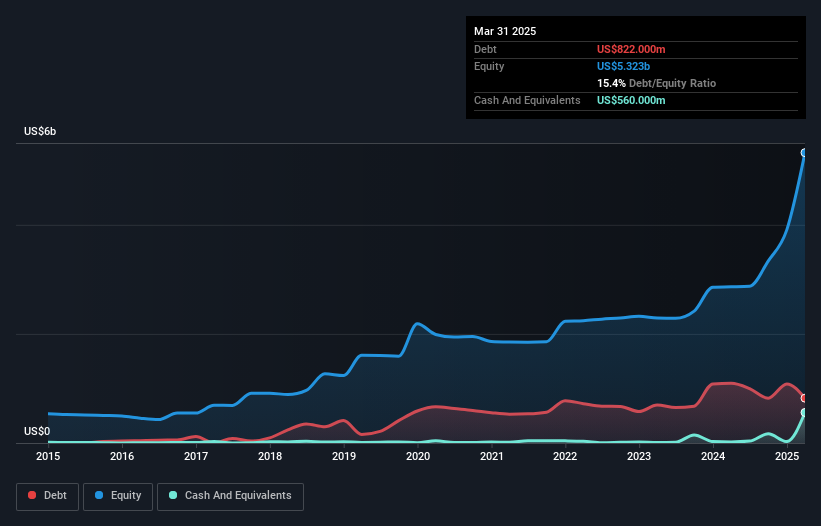Legendary fund manager Li Lu (who Charlie Munger backed) once said, 'The biggest investment risk is not the volatility of prices, but whether you will suffer a permanent loss of capital.' When we think about how risky a company is, we always like to look at its use of debt, since debt overload can lead to ruin. We note that Viper Energy, Inc. (NASDAQ:VNOM) does have debt on its balance sheet. But the more important question is: how much risk is that debt creating?
Our free stock report includes 3 warning signs investors should be aware of before investing in Viper Energy. Read for free now.Why Does Debt Bring Risk?
Debt and other liabilities become risky for a business when it cannot easily fulfill those obligations, either with free cash flow or by raising capital at an attractive price. In the worst case scenario, a company can go bankrupt if it cannot pay its creditors. However, a more common (but still painful) scenario is that it has to raise new equity capital at a low price, thus permanently diluting shareholders. Of course, debt can be an important tool in businesses, particularly capital heavy businesses. When we think about a company's use of debt, we first look at cash and debt together.
What Is Viper Energy's Debt?
As you can see below, Viper Energy had US$822.0m of debt at March 2025, down from US$1.09b a year prior. However, it also had US$560.0m in cash, and so its net debt is US$262.0m.

How Strong Is Viper Energy's Balance Sheet?
The latest balance sheet data shows that Viper Energy had liabilities of US$91.0m due within a year, and liabilities of US$824.0m falling due after that. Offsetting these obligations, it had cash of US$560.0m as well as receivables valued at US$189.0m due within 12 months. So it has liabilities totalling US$166.0m more than its cash and near-term receivables, combined.
Having regard to Viper Energy's size, it seems that its liquid assets are well balanced with its total liabilities. So while it's hard to imagine that the US$9.08b company is struggling for cash, we still think it's worth monitoring its balance sheet.
View our latest analysis for Viper Energy
We measure a company's debt load relative to its earnings power by looking at its net debt divided by its earnings before interest, tax, depreciation, and amortization (EBITDA) and by calculating how easily its earnings before interest and tax (EBIT) cover its interest expense (interest cover). This way, we consider both the absolute quantum of the debt, as well as the interest rates paid on it.
Viper Energy has net debt of just 0.30 times EBITDA, indicating that it is certainly not a reckless borrower. And it boasts interest cover of 9.7 times, which is more than adequate. Fortunately, Viper Energy grew its EBIT by 2.3% in the last year, making that debt load look even more manageable. When analysing debt levels, the balance sheet is the obvious place to start. But it is future earnings, more than anything, that will determine Viper Energy's ability to maintain a healthy balance sheet going forward. So if you want to see what the professionals think, you might find this free report on analyst profit forecasts to be interesting.
Finally, a company can only pay off debt with cold hard cash, not accounting profits. So the logical step is to look at the proportion of that EBIT that is matched by actual free cash flow. Considering the last three years, Viper Energy actually recorded a cash outflow, overall. Debt is far more risky for companies with unreliable free cash flow, so shareholders should be hoping that the past expenditure will produce free cash flow in the future.
Our View
Both Viper Energy's ability to handle its debt, based on its EBITDA, and its interest cover gave us comfort that it can handle its debt. In contrast, our confidence was undermined by its apparent struggle to convert EBIT to free cash flow. Considering this range of data points, we think Viper Energy is in a good position to manage its debt levels. But a word of caution: we think debt levels are high enough to justify ongoing monitoring. When analysing debt levels, the balance sheet is the obvious place to start. However, not all investment risk resides within the balance sheet - far from it. To that end, you should learn about the 3 warning signs we've spotted with Viper Energy (including 1 which can't be ignored) .
When all is said and done, sometimes its easier to focus on companies that don't even need debt. Readers can access a list of growth stocks with zero net debt 100% free, right now.
New: Manage All Your Stock Portfolios in One Place
We've created the ultimate portfolio companion for stock investors, and it's free.
• Connect an unlimited number of Portfolios and see your total in one currency
• Be alerted to new Warning Signs or Risks via email or mobile
• Track the Fair Value of your stocks
Have feedback on this article? Concerned about the content? Get in touch with us directly. Alternatively, email editorial-team (at) simplywallst.com.
This article by Simply Wall St is general in nature. We provide commentary based on historical data and analyst forecasts only using an unbiased methodology and our articles are not intended to be financial advice. It does not constitute a recommendation to buy or sell any stock, and does not take account of your objectives, or your financial situation. We aim to bring you long-term focused analysis driven by fundamental data. Note that our analysis may not factor in the latest price-sensitive company announcements or qualitative material. Simply Wall St has no position in any stocks mentioned.
About NasdaqGS:VNOM
Viper Energy
Owns, acquires, and exploits oil and natural gas properties in North America.
Excellent balance sheet and good value.
Similar Companies
Market Insights
Community Narratives




